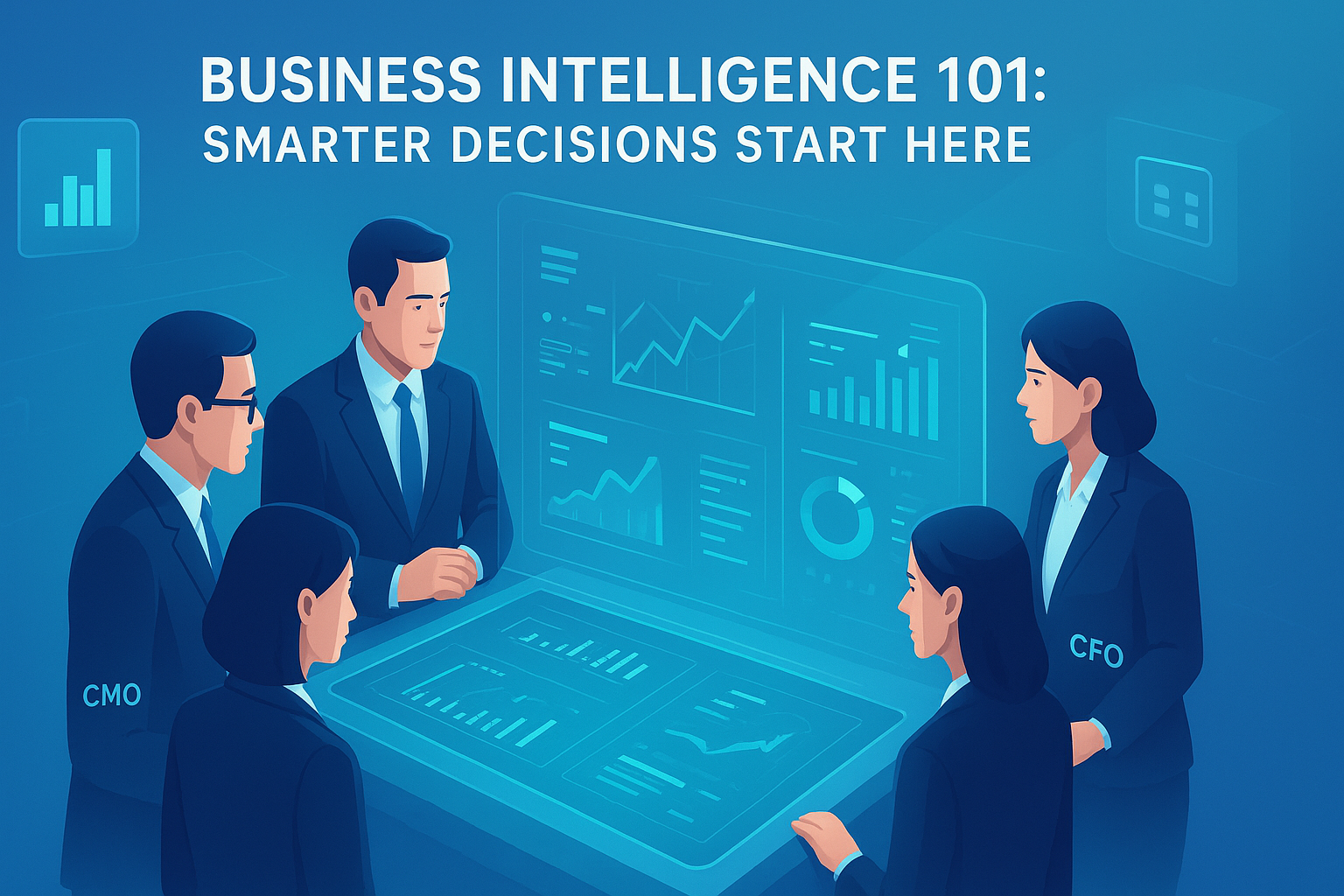Business Intelligence 101: What Every Leader Needs to Know
In today’s world, where data is quickly becoming the new oil, Business Intelligence (BI) is no longer an extravagance—it’s a leadership necessity. For C-suite leaders and decision-makers, BI takes disjointed enterprise data and turns it into mighty insights that spur growth, efficiency, and competitive edge.
But still, most organizations wrestle with core questions: What is business intelligence? Why do we need it? And how do we begin?
This BI newbie’s guide addresses these questions and more—designed for leaders navigating digital transformation and growth initiatives.
-
BI = Intelligent Choices. It converts data into useful insights for strategic decision-making.
-
Tools + Strategy. BI involves tools, dashboards, data models, and culture.
-
Not Just IT’s Job. From finance to marketing, BI enables all functions.
-
Begin with a BI Maturity Assessment. Know where you are and how to grow successfully.
What Is Business Intelligence (BI)?
Simply put, business intelligence is the technologies, practices, and methodologies that gather, analyze, and deliver business data. The objective? To enable more informed decision-making.
BI enables leaders:
-
To examine past performance
-
Predict future trends
-
Identify operation inefficiencies
-
Fuel growth with data-driven strategy
How is BI different from data analytics?
BI is diagnostic and descriptive—concerned with figuring out what and why. Data analytics tends to go deeper into predictive and prescriptive spaces.
Why Business Intelligence Matters to Enterprise Leaders
Regardless of whether you are a CTO in fintech or a CFO in manufacturing, BI enables you to:
1. Make Data-Driven Decisions
BI enables leadership teams to eliminate gut feelings in favor of insight. For instance:
-
CMOs leverage BI dashboards to monitor campaign ROI by channel.
-
CFOs watch cash flow and AR patterns and predict financial risk.
2. Enhance Operational Effectiveness
BI solutions consolidate data from throughout departments—finance, sales, and supply chain—identifying bottlenecks and opportunities for improvement.
Up to 5x better decision-making comes from new-generation BI platforms, says Gartner.
3. Enable Teams with Self-Service BI
Current BI solutions such as Power BI, Tableau, and Looker offer drag-and-drop dashboards, minimizing IT reliance and allowing business consumers to analyze insights as and when they want.
Essential Elements of a Business Intelligence Initiative
A successful BI project integrates technology, governance, and culture. Essential elements include:
🔹Data Integration
Integrate data from CRMs, ERPs, spreadsheets, and third-party solutions into a single data warehouse or lake.
🔹Data Modeling
Construct integrated data models that specify KPIs and metrics by departments.
🔹BI Dashboards & Reporting
Interactive displays that offer immediate visibility into business performance.
🔹Governance & Security
Define data ownership, access rules, and controls for compliance.
What are some examples of BI dashboards?
Some examples are sales forecast dashboards, financial results reports, customer churn analysis, and executive scorecards.

Starting with BI: A Step-by-Step Guide
Step 1: Evaluate Current Maturity
Assess your current tools, data stack, and user capabilities.
Step 2: Align Business Objectives with BI Initiatives
Align use cases that map to strategic KPIs (e.g., decrease churn, maximize cash flow, and speed product launches).
Step 3: Select Appropriate Tools
Look at platforms that align with your size, security requirements, and users (Power BI for the Microsoft platform, Looker for Google Cloud, etc.).
Step 4: Develop Your Data Team
Invest in data engineers, BI analysts, and governance leads—or have an external partner execute faster.
Step 5: Train & Evangelize
Make adoption happen through training, use-case demos, and executive sponsorship.
Ready to revolutionize your decision-making process?
Speak with our BI specialists today
Common Business Intelligence Use Cases by Role
|
Role |
BI Use Case Example |
|
CIO/CTO |
Track IT spend, performance of digital transformation |
|
CMO |
Measure campaign effectiveness and customer acquisition |
|
CFO |
Forecast revenue, track working capital |
|
COO |
Monitor supply chain KPIs and operational KPIs |
|
Sales Director |
Pipeline health, conversion rates, regional performance |
BI Implementation Mistakes to Avoid
-
Boiling the ocean: Attempting BI of everything simultaneously
-
Lack of executive buy-in: Leadership alignment is necessary for adoption
-
Ignoring data governance : results in poor trust in reports and decision paralysis
Why do BI projects fail?
Typical reasons include ambiguous goals, incorrect data, no user training, or lack of executive support
Frequently Asked Questions
Q1. Which are the top BI tools for businesses?
Power BI, Tableau, Qlik, Looker, and Sisense are the popular ones. It all depends on your stack, scale, and use cases.
Q2. Is BI equal to data analytics?
BI is a form of analytics that deals with descriptive insights only. Analytics encompasses more sophisticated techniques such as AI, ML, and predictive modeling as well.
Q3. How much does it cost to set up a BI?
It varies by size. Small projects can begin under $20,000; enterprise-level BI ecosystems can run over $500K with data warehouses, ETL, etc.
Q4. Who owns BI in an organization?
Generally, it’s a cross-functional initiative spearheaded by the CTO, CIO, or a Head of Data/BI supported by business units.
Q5. How long does BI implementation take?
A pilot project can be 4–6 weeks. Enterprise-wide implementations can range from 6 to 12 months based on scope and readiness.
Obtain a free BI maturity assessment—find out where you are and how you can improve.
Begin now.
![]()





